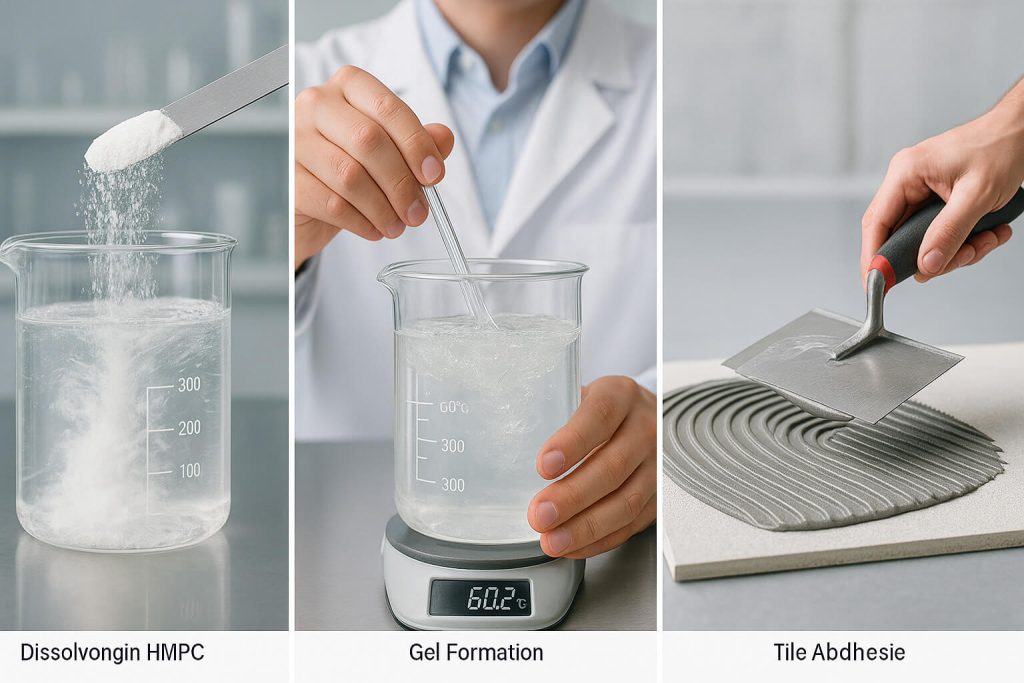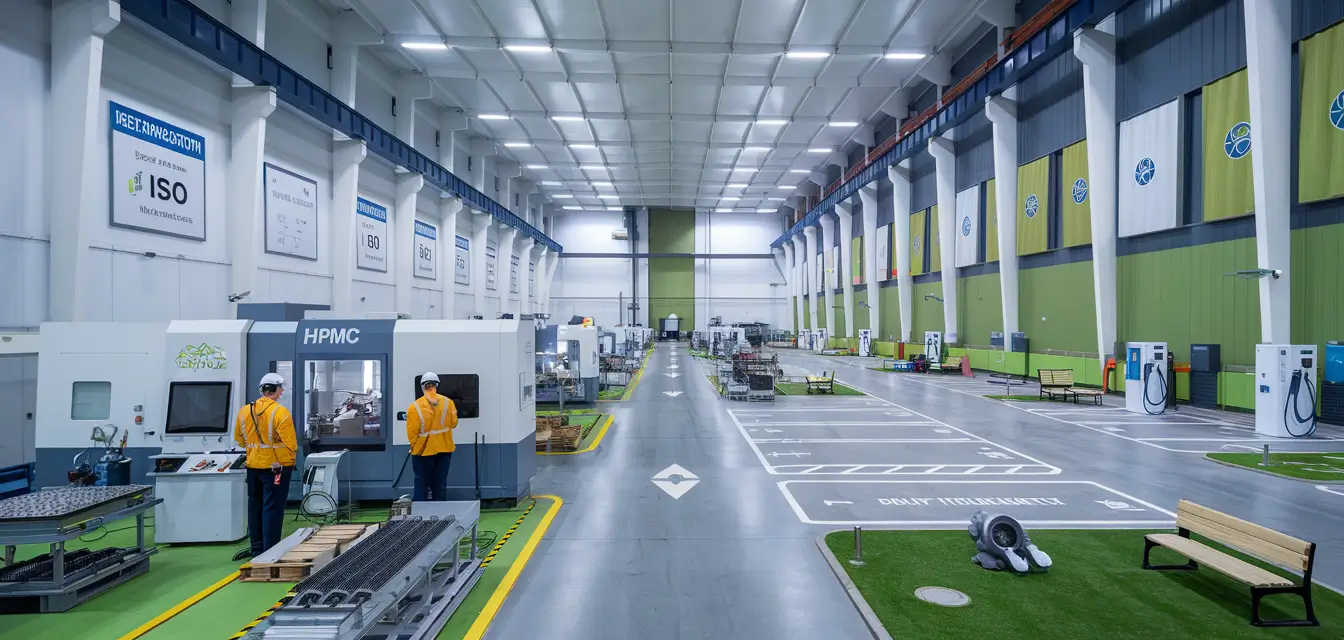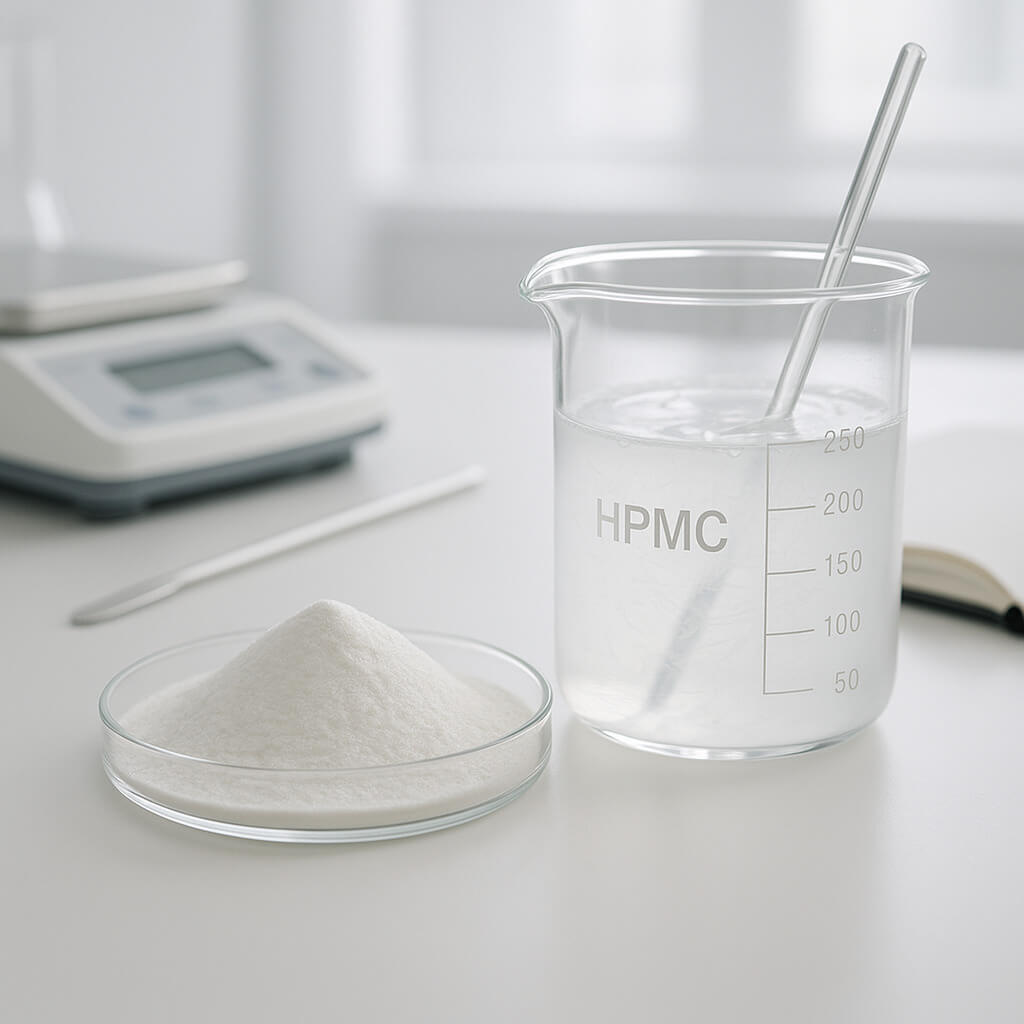Hydroxypropyl Methylcellulose (HPMC) is a versatile polymer that plays a significant role in various industries, ranging from pharmaceuticals to construction and food production. Known for its ability to dissolve in water and form gels, HPMC’s unique properties make it a valuable ingredient in many formulations. This article delves into the key properties of HPMC and explores how they are leveraged in different industrial applications. From enhancing product quality to ensuring environmental sustainability, understanding HPMC’s benefits is essential for professionals in the field.

1. What is HPMC and How Does It Work in Industry?
Hydroxypropyl Methylcellulose (HPMC) is a semi-synthetic polymer made by modifying cellulose, a natural plant-derived material. Through the introduction of hydroxypropyl and methyl groups, HPMC becomes water-soluble, forming gel-like substances that are ideal for various applications. This chemical modification makes HPMC both versatile and functional, allowing it to perform a wide array of tasks, such as thickening, emulsifying, and binding.
In industrial settings, the ability of HPMC to dissolve in both cold and hot water makes it an excellent choice for pharmaceutical, food, and construction applications. It is used in tablet formulations as a binder, stabilizer, and controlled-release agent in the pharmaceutical industry. In food production, HPMC acts as a thickener and emulsifier, ensuring that products maintain the desired texture and consistency. Additionally, in construction, HPMC’s water retention and adhesion-enhancing properties make it a critical ingredient in mortars and adhesives.
By improving product performance and ensuring consistent quality, HPMC’s role in industrial applications cannot be overstated. Understanding its properties helps manufacturers optimize formulations, enhance product stability, and meet the demands of various industries.
| Industry | Applications | Role of HPMC |
|---|---|---|
| Pharmaceuticals | Binders, controlled-release agents | Consistency, controlled drug release |
| Food | Emulsifiers, stabilizers, thickeners | Texture, consistency, shelf-life |
| Construction | Mortars, adhesives | Water retention, workability, adhesion |
2. What Are the Key Physical and Chemical Properties of HPMC?
The key properties of HPMC are what make it a preferred choice in various industrial applications. These properties include water solubility, viscosity control, gel formation, thermal stability, and biodegradability. Each property plays a crucial role in determining the polymer’s functionality across different industries.
Water Solubility is perhaps the most significant property of HPMC. It allows the polymer to dissolve in both cold and hot water, making it ideal for use in products that require uniform texture and stability. Whether it is used in pharmaceuticals to form a tablet matrix or in food to stabilize emulsions, HPMC’s solubility ensures consistent results.
Viscosity Control is another essential feature. HPMC can modify the viscosity of solutions, which is valuable in both pharmaceutical and food formulations. In pharmaceuticals, it helps control the flowability of active ingredients in tablets, while in food, it provides the right thickness for sauces and dressings.
Gel-Forming Ability makes HPMC especially useful in controlled-release formulations for drugs. By forming a gel matrix, it regulates the release rate of active ingredients, ensuring that the drug is released slowly and consistently over time.
Thermal Stability ensures that HPMC retains its functional properties when exposed to varying temperatures, which is particularly beneficial in the food and construction industries.
Finally, Biodegradability makes HPMC an eco-friendly option for industries seeking sustainable solutions. As environmental concerns grow, HPMC’s ability to decompose naturally is a key selling point.
| Property | Functionality | Application |
|---|---|---|
| Water Solubility | Dissolves easily in water | Pharmaceuticals, food, construction |
| Viscosity Control | Adjusts the thickness of solutions | Pharmaceuticals, food |
| Gel-Forming Ability | Forms gels for controlled release | Pharmaceuticals, construction |
| Thermal Stability | Maintains stability at various temperatures | Pharmaceuticals, food |
| Biodegradability | Breaks down naturally | Environmentally friendly applications |
3. How is HPMC Utilized in Pharmaceutical Formulations?
HPMC’s role in the pharmaceutical industry is indispensable. It is widely used as a binder in tablet formulations, where it helps bind the active ingredients together, ensuring the tablet’s structural integrity. Without HPMC, tablets might crumble or fail to deliver the active ingredient efficiently. By forming a uniform and cohesive mass, HPMC ensures that the active ingredients are evenly distributed and that the tablet remains intact during handling and ingestion.
Another key function of HPMC in pharmaceuticals is its ability to control drug release. Controlled-release formulations are vital in ensuring that a drug is released gradually over time, providing sustained therapeutic effects. HPMC acts as the matrix that holds the drug and regulates its release, ensuring a steady, controlled delivery throughout the day.
Additionally, HPMC is used in topical and transdermal products. In these applications, HPMC forms gels that hold active pharmaceutical ingredients in a stable matrix, allowing for effective skin absorption. Its gel-forming ability ensures that the product remains intact and that the active ingredients are delivered consistently over time.
| Pharmaceutical Application | Function | Benefit |
|---|---|---|
| Binder | Holds active ingredients together | Ensures tablet integrity, even drug release |
| Controlled Release | Regulates the release of drugs | Steady therapeutic effect, reduced dosing frequency |
| Gels and Topical Products | Forms stable matrices for topical products | Effective skin absorption, stability |
4. What Are the Benefits of HPMC in Food and Beverage Production?
In the food industry, HPMC is used primarily as a thickener, emulsifier, and stabilizer. Its versatility in modifying the texture and consistency of food products makes it essential in many formulations. As a thickener, HPMC helps improve the mouthfeel and viscosity of products such as sauces, soups, and dressings. By increasing the viscosity, HPMC provides the right texture, ensuring that the product does not separate or become too watery.
Emulsification is another vital role of HPMC in food. It is used in products like mayonnaise, salad dressings, and ice cream, where it helps keep oil and water phases together. Without HPMC, these products would experience phase separation, which would lead to inconsistent textures and poor consumer experience.
Stabilization is equally important in food production. In products like gluten-free foods and plant-based formulations, HPMC helps maintain consistency and texture, providing a product that mimics traditional formulations while offering the necessary functional properties. HPMC also extends the shelf life of food products, preventing them from spoiling prematurely.
| Food Application | Function | Benefit |
|---|---|---|
| Thickener | Increases viscosity in sauces, soups | Provides texture, prevents separation |
| Emulsifier | Keeps oil and water in suspension | Ensures uniform texture, stability |
| Stabilizer | Maintains consistency, extends shelf life | Preserves product quality, improves texture |
5. How is HPMC Used in the Construction Industry?
In the construction industry, HPMC plays a significant role as an additive in dry-mix mortars, plasters, and tile adhesives. Its primary function is to improve the workability of these materials, making them easier to mix, apply, and spread. Mortars and plasters can often become too thick or hard to work with, but HPMC ensures a smooth, consistent mixture that is easy to handle.
Another important function of HPMC is water retention. In dry-mix mortars and plasters, HPMC helps retain water, preventing the mixture from drying out too quickly during application. This allows for proper curing, ensuring that the material sets correctly and forms strong bonds. Without proper water retention, the material could dry prematurely, leading to cracks and reduced strength.
Adhesion improvement is another benefit of using HPMC in construction. It enhances the adhesion properties of tile adhesives, ensuring that tiles stay firmly in place once applied. This results in longer-lasting installations and fewer maintenance issues in the long run.
| Construction Application | Function | Benefit |
|---|---|---|
| Dry-Mix Mortars | Improves workability, prevents clumping | Easy mixing and application |
| Plasters | Enhances water retention | Ensures proper curing, prevents cracks |
| Adhesives | Improves adhesion and bonding | Strong, durable bond |
6. How Can HPMC Contribute to Sustainable Practices and Green Manufacturing?
In the face of growing environmental concerns, HPMC offers several key advantages for industries seeking more sustainable alternatives. HPMC is biodegradable, meaning that it breaks down naturally without causing harm to the environment. This biodegradability makes HPMC an attractive option for companies looking to reduce their environmental footprint.
In construction, HPMC contributes to green building materials by replacing synthetic chemicals that may not be environmentally friendly. Using HPMC helps reduce the reliance on petroleum-based ingredients, promoting sustainability in construction.
In the food industry, HPMC is a plant-based alternative to animal-derived ingredients like gelatin, aligning with the increasing demand for vegan and vegetarian products. By substituting these ingredients with HPMC, manufacturers can produce more sustainable, ethical food options that cater to a wider consumer base.
| Environmental Benefit | Description | Application |
|---|---|---|
| Biodegradability | Breaks down naturally in the environment | Green construction, eco-friendly food production |
| Eco-Friendly | Sustainable alternative to synthetic polymers | Green building materials, sustainable food options |
7. How Can HPMC Be Customized for Different Industrial Uses?
One of HPMC’s standout features is its ability to be customized for various industrial applications. Manufacturers can modify viscosity, dissolution rate, and degree of substitution to tailor HPMC to specific needs.
In the pharmaceutical industry, adjusting the dissolution rate allows for the creation of controlled-release drug formulations. This enables manufacturers to design medications that release their active ingredients slowly over time, improving therapeutic outcomes and reducing the need for frequent dosing.
In the food industry, adjusting the viscosity of HPMC ensures that the product has the desired texture, whether it’s thickening a soup or emulsifying a dressing. For construction, customizing the degree of substitution helps improve the adhesion and workability of dry-mix mortars and adhesives.
| Customization Aspect | Function | Benefit |
|---|---|---|
| Viscosity Control | Adjusts thickness of solutions | Tailored performance for various industries |
| Dissolution Rate | Controls drug release or emulsification rate | Extended release, consistent texture |
| Degree of Substitution | Influences solubility and gel formation | Fine-tuned properties for specific needs |
8. What Are the Common Challenges in the Use of HPMC?
While HPMC offers many advantages, there are some challenges in its use. One of the most common challenges is inconsistent dissolution. When working with large batches, it can be difficult to ensure that HPMC dissolves uniformly, which can result in inconsistent product quality.
Temperature sensitivity is another issue. While HPMC is stable within a certain temperature range, excessive heat can degrade the polymer and reduce its effectiveness. Care must be taken to maintain the correct processing temperatures.
Finally, cost and supply chain issues can impact the availability and price of HPMC. Depending on the source of cellulose and the degree of modification, fluctuations in price and availability can affect the overall cost of production.
| Challenge | Cause | Solution |
|---|---|---|
| Inconsistent Dissolution | Incorrect mixing, water-to-polymer ratio | Ensure proper dissolution techniques, quality control |
| Temperature Sensitivity | Degradation at high temperatures | Maintain optimal processing conditions |
| Supply Chain Issues | Fluctuations in raw material prices |
and availability | Source reliable suppliers, optimize production |
9. Are There Alternatives to HPMC in Various Applications?
While HPMC is highly effective, there are alternative polymers that serve similar functions. Methylcellulose (MC) is one such alternative, known for its ability to form gels at higher temperatures. However, MC’s gel-forming ability limits its versatility compared to HPMC, making HPMC a more preferred choice in many applications.
Carboxymethylcellulose (CMC) is another alternative, especially used for viscosity modification. CMC is common in the food and pharmaceutical industries but lacks the gel-forming capabilities that make HPMC more adaptable.
Despite the existence of these alternatives, HPMC remains a go-to polymer due to its combination of properties, including water solubility, gel formation, and viscosity control.
| Alternative | Key Features | Application |
|---|---|---|
| Methylcellulose | Gel formation at higher temperatures | Food, pharmaceuticals |
| Carboxymethylcellulose | Viscosity control | Food, pharmaceuticals |
| HPMC | Water solubility, gel-forming | Pharmaceuticals, construction, food |
Conclusion
In conclusion, Hydroxypropyl Methylcellulose (HPMC) is a versatile and essential polymer used in numerous industries for its unique properties. Its water solubility, viscosity control, gel-forming ability, and thermal stability make it an invaluable ingredient in pharmaceuticals, food, and construction. As industries look to adopt more sustainable practices, HPMC’s biodegradability and eco-friendly nature only increase its value. Despite challenges like temperature sensitivity and supply chain variability, HPMC’s benefits far outweigh the drawbacks, making it a go-to choice for manufacturers worldwide.
FAQ
Q1: What is Hydroxypropyl Methylcellulose (HPMC)?
HPMC is a cellulose-derived polymer used as a binder, emulsifier, and stabilizer in various industries such as pharmaceuticals, food, and construction.
Q2: How does HPMC function in pharmaceutical applications?
HPMC serves as a binder in tablets and helps control the release of active ingredients in controlled-release formulations, ensuring consistent drug delivery.
Q3: What role does HPMC play in the food industry?
HPMC is used as a thickener, emulsifier, and stabilizer, improving texture and consistency in food products and acting as a vegan alternative to traditional ingredients like gelatin.
Q4: How does HPMC benefit the construction industry?
In construction, HPMC improves the workability and adhesion of mortars and adhesives, while also helping retain water for better curing and durability.
Q5: Are there alternatives to HPMC?
Alternatives like Methylcellulose and Carboxymethylcellulose offer similar properties, but HPMC remains the preferred choice due to its versatile functionality and performance in a wide range of industries.




